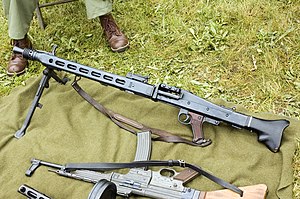MG 42
| MG 42 | |
|---|---|

MG 42 (top)
|
|
| Type | General-purpose machine gun |
| Place of origin | Nazi Germany |
| Service history | |
| In service | 1942–present |
| Wars |
World War II Portuguese Colonial War Yugoslav Wars Syrian Civil War |
| Production history | |
| Designer | Werner Gruner |
| Designed | 1942 |
| Manufacturer |
Mauser Werke AG |
| Produced | 1942–1945 (Nazi Germany) |
| Number built | 423,600 |
| Variants | MG 45/MG 42V, MG 1, MG 2, Rheinmetall MG 3, M53, MG 74 |
| Specifications | |
| Weight | 11.57 kg (25.51 lb) |
| Length | 1,220 mm (48 in) |
| Barrel length | 533 mm (21.0 in) |
|
|
|
| Cartridge | 7.92×57mm Mauser |
| Action | Recoil-operated, roller-locked |
| Rate of fire | 1,200 rounds/min (varied between 900–1,500 rounds/min with different bolts) |
| Muzzle velocity | 740 m/s (2,428 ft/s) (s.S. Patrone) |
| Effective firing range | 200–2,000 m (219–2,187 yd) sight adjustments 3,500 m (3,828 yd) with tripod and telescopic sight |
| Maximum firing range | 4,700 m (5,140 yd) |
| Feed system | 50 or 250-round belt |
| Sights | Iron sights, antiaircraft sight or telescopic sights |
Mauser Werke AG
Wilhelm-Gustloff-Stiftung
Steyr-Daimler-Puch,
The MG 42 (shortened from German: Maschinengewehr 42, or "machine gun 42") is a 7.92×57mm Mauser general purpose machine gun designed in Nazi Germany and used extensively by the Wehrmacht and the Waffen-SS during the second half of World War II. It was intended to replace the earlier MG 34, which was more expensive and took much longer to produce, but in the event, both weapons were produced until the end of the war.
The MG 42 has a proven record of reliability, durability, simplicity, and ease of operation, but is most notable for its ability to produce a high volume of suppressive fire.
The MG 42's lineage continued past Nazi Germany's defeat, forming the basis for the nearly identical MG1 (MG 42/59), chambered in 7.62×51mm NATO, which subsequently evolved into the MG1A3, and later the Bundeswehr's MG 3. It also spawned the Swiss MG 51, Zastava M53, SIG MG 710-3, Austrian MG 74, and the Spanish 5.56×45mm NATO Ameli light machine gun, and lent many design elements to the American M60 and Belgian MAG. The MG 42 was adopted by several armed organizations after the war, and was both copied and built under licence.
Even prior to World War I the German army was already looking forward to replacing the heavy machine guns which proved to be such a success in that war. The MG13 was one of the first developments toward a goal of producing a weapon that could perform multiple roles, rather than just one. The MG13 was the result of reengineering the Dreyse Water cooled machine gun to fit the new requirement. The Gast gun was developed with the goal of providing a high rate of fire weapon for anti-aircraft use which was reported to have reached rates of fire as high as 1600 rpm.
...
Wikipedia
